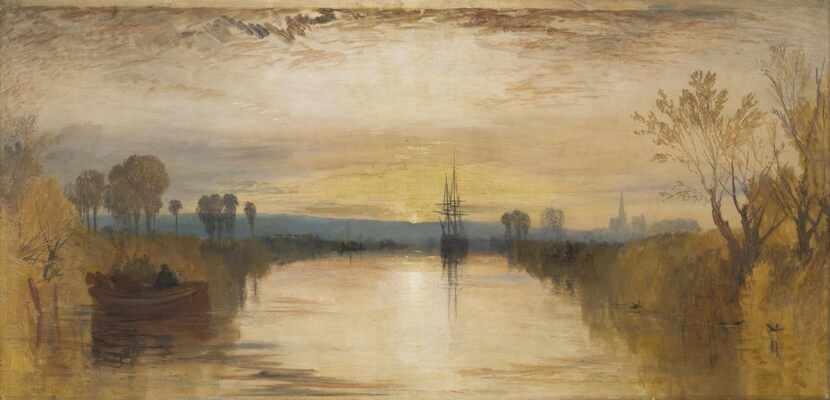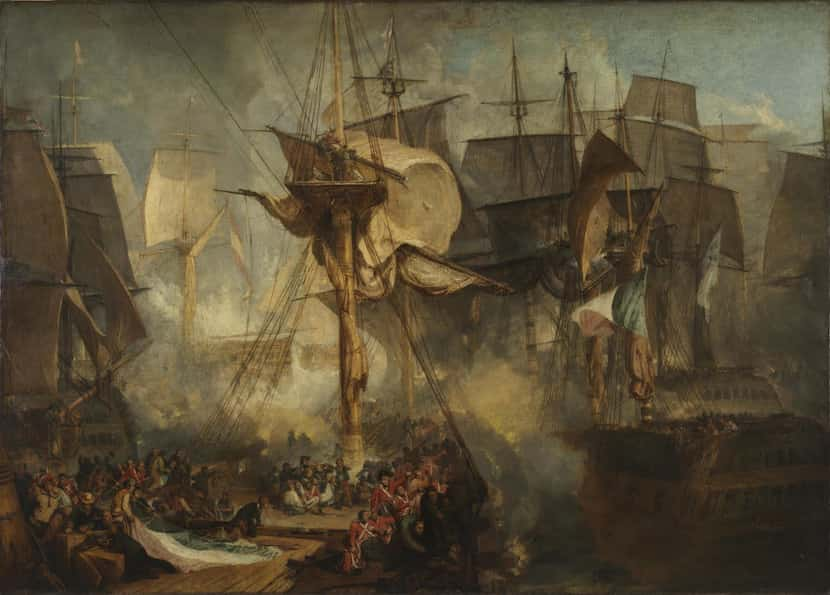FORT WORTH — As evidence that life imitates art, Oscar Wilde credited French impressionist painters for “those wonderful brown fogs that come creeping down our streets, blurring the gas-lamps and changing the houses into monstrous shapes … the lovely silver mists that brood over our river, and turn to faint forms of fading grace curved bridge and swaying barge. …
“People see fogs, not because there are fogs, but because poets and painters have taught them the mysterious loveliness of such effects.”
Although Wilde, writing in 1889, pooh-poohed Joseph Mallord William Turner as passé, the honor for transforming atmospheric perceptions in 19th century London surely belonged to the earlier English painter. While his contemporary, John Constable, celebrated England’s green and pleasant land — mostly rural, or at most small-town — Turner portrayed urban scenes garishly lit through coal-fired smogs. Bringing new dynamism to art, he also dramatized conflagrations and wartime destruction.
That fondness for visual drama has stuck Turner with the “romantic” label. But “Turner’s Modern World,” a spectacular exhibition of paintings, watercolors and sketches at the Kimbell Art Museum, portrays Turner as a pioneering observer of social and political, as well as environmental, transformations. Based on rich holdings of Tate Britain, where it was first displayed, it includes loans from other British and American museums unavailable in London due to COVID shipping restrictions. From Fort Worth it will go to the Museum of Fine Arts Boston.
Turner (1775-1851) lived through turbulent times. The American and French revolutions and the French Revolutionary and Napoleonic wars destabilized two continents. The coal-fired Industrial Revolution brought new factories, steamships and locomotives, spewing toxic fumes and poisoning rivers. Although slavery was outlawed in 1833 — 30 years before the U.S. took the same step — nouveaux riches of industry exploited the have-nots in squalid servitude. To varying degrees, all these forces surface in Turner’s art.
Obviously gifted from an early age, Turner had traditional training at the Royal Academy of Arts, alongside work as a draftsman for several architects. With an early eye for attracting sales and patronage, he could produce genre paintings and watercolors — landscapes and seascapes.
The aristocratic partiers in Richmond Hill, on the Prince Regent’s Birthday look barely updated from Claude Lorrain and Watteau. The exquisitely atmospheric Chichester Canal silhouettes an upstream schooner against a yellow sunset that tints grassy shores in the foreground. (As Dallasites know, airborne pollution can produce spectacular sunsets.) Defying romantic clichés, though, Turner also portrayed laborers in claustrophobic versions of Blake’s dark satanic mills.

He had a fondness for turbulent sea scenes, with vessels tossed on roiling waters, sometimes lashed by swirling rains and snows. There’s scarcely room for nature, though, in The Battle of Trafalgar, as Seen from the Mizen Starboard Shrouds of the Victory. French and English ships, borne upon a penumbra of cannon smoke, with sails billowing every which way, are crowded impossibly forward. Conflating scenes of battle and aftermath, Turner portrays the mortally wounded Admiral Nelson at the center, even as the French commanders surrender on the left.

Turner repeatedly returned to scenes of ships in distress, sometimes in densely abstract realizations, with oils thickly laid on. Rockets and Blue Lights (Close at Hand) to Warn Steamboats of Shoal Water is a seasick swirl of clouds, smoke, seafoam and warning flares.
We get all of the Four Elements — earth (barely), water, air and fire — in The Burning of the Houses of Lords and Commons, October 16, 1834. In a concatenation of thickly stroked yellow, orange, red, purple and gray, the flames are windswept diagonally across the distant scene. Shadowy onlookers cluster at water’s edge and on boats immobilized at low tide. To early viewers, with so much changing in British life, this scene must have seemed symbolic — or portentous.
In 1870, with the Franco-Prussian War ravaging Paris, French painters of the inchoate impressionist movement fled to London. There they were struck by Turner’s atmospheres, energized by tight juxtapositions of contrasting colors. They would develop the concept in very different ways, but in the meantime Monet was captivated by, and illustrated, London scenes viewed through those “new” fogs.
If Turner wasn’t exactly a precursor of impressionism, he was, like the French painters to come, a virtuoso of atmospheric effects. Later paintings less about concrete things and more about forces and gestures and paint itself can seem precedents for abstract expressionism more than a century later.
The painterly flair, the dramatic engagement with sometimes violent natural forces, industrial change and political upheaval: all this is extensively, and spectacularly, displayed at the Kimbell. A worthy successor to the great 2008 Turner show at the Dallas Museum of Art, this is a must-see.
Details
“Turner’s Modern World” is on view through Feb. 6, 2022 at the Kimbell Art Museum, 3333 Camp Bowie Blvd., Fort Worth. Special exhibition fee $18; discounts for children, students and seniors. 10 a.m. to 5 p.m. Tuesday, Wednesday, Thursday and Saturday; noon to 8 p.m. Friday; noon to 5 p.m. Sunday. 817-332-8451, kimbellart.org.
Staff classical music critic of The News from 1999 to 2015, sometimes also writing about art and architecture, Scott Cantrell continues contributing as a freelance writer.


/cloudfront-us-east-1.images.arcpublishing.com/dmn/D4FJ726DTR6SREKVO4SCKYKNEE.jpg)
/cloudfront-us-east-1.images.arcpublishing.com/dmn/VVGIMAHWGFF2BPST7A36S4AYJY.jpg)
/cloudfront-us-east-1.images.arcpublishing.com/dmn/OM2IDS6SQBE33ADVQBOHVMSWBE.jpg)
/cloudfront-us-east-1.images.arcpublishing.com/dmn/YH4SVORUYHKSJ64K6VBOV7FDIU.jpg)
/cloudfront-us-east-1.images.arcpublishing.com/dmn/5AJVFJU2ORBDTFBQSTEZQXAH4E.jpg)